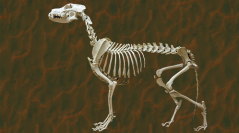

 Anthropozoologica
58 (2) - Pages 9-22
Anthropozoologica
58 (2) - Pages 9-22Of all domestic animals, dogs (Canis familiaris Linnaeus, 1758) have developed the tightest bond with humans during the history of civilization. Regardless of their chronological affiliation, articulated dog skeletons discovered in structured deposits show individuals within their biological contexts; their ageing and sexing are usually possible and even pathological histories can be reconstructed. This presentation is a concise review of five Migration Period (5th-6th century CE) deposits from western Hungary, the former territory of Roman Pannonia province. These burials are examples of dogs being interred with other animals as well as humans under various circumstances. The integration of multidisciplinary information in reconstructing both the morphotype and likely socio-cultural status of 13 individuals showed the presence of unusually large dogs in human burials by both late Antique and present-day standards. This raises the question of whether these large dogs were associated with humans or occasions that were seen as particularly significant. Could any large dog be added to the burial of a human considered important enough? The dualistic perceptions of dogs in the historical/ethnographic record offer a broad range of interpretations. The results of high-resolution zoological analysis provided by complete dog skeletons can contribute to a better understanding of dog-human relationships as well as the perception and value of individual dogs to people.
Animal burials, withers height, companion animals, social status of dogs.